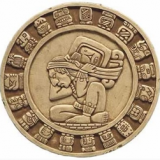Numerology and Sacred Geometry: Wizards of Wall Street: Part 2 of 3
Sacred Geometry and Numerology are also used in various forms in the financial markets. William D. Gann was knonwn as one of the truly great exponents of these techniques; with a reputation as the greatest trader who ever lived. Anyone interested in techniques as this would do well to study Gann’s books and courses.
Most of his methods center around the circle, and the divisions of the circle. The numbers 360, 270, 240, 180, 144, 120, 90, 72, 60, 45 are all important in the financial markets, as they are all exact fractions of a circle. As an example: 270 is 3/4 of a 360 degree circle.
Price charts are another example where all of these numbers are found to be very important ton study. When doing so you will find that a market makes a top exactly ninety days/weeks/months following a previous top or bottom. For astrologers 90 degrees is known to be an aspect called a Square
Gann also used all sorts of strange charts that would not have looked out of place in a magician’s secret chamber. An example is the “Square of 9” chart showing a number spiral that commences with 1 in the center position. Then the numbers 2-9 then are shown spiraling around to form a second layer. This is then followed by all the other numbers in successive layers as the move outward and get progressively larger.
This was just one of Gann’s square charts. He also did number sequences in other formats such as hexagons, triangles, and circles. With these same tools, you can plot major market turning points, and continue on to study the relationships between them by using the circular angles defined above. You can note how the price of the top which was formed last week will be “trine (120)” to some major previous top or bottom. When working with Astrology you will also find ways to combine these charts with the astrological charts.
Llonger term price charts can be used as well. Often, you will find that a market top/bottom occurs 120 months after a previous top/bottom. And this also points to another important market geometry. After all, is 120 months is equal to a major time sequence of exactly 10 years. History shows that markets often turn on anniversary dates; ten years, five years, one year, six months etc., after a previous major turning point.
If you look forward on a long-term price chart from a major previous top or bottom, you will often find other major turns 5, 10, 15 years and more into the future. By studying Gann you will learn how he kept charts going back decades (such as Wheat) and, in a couple of cases even centuries!






